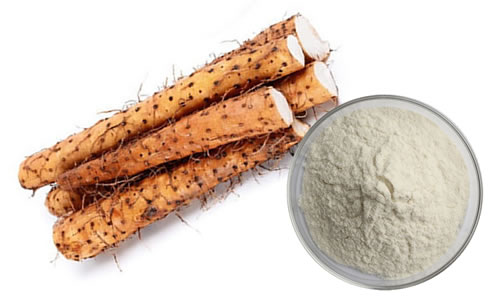Yam extract (diosgenin 98%)
[product name]: yam extract
[English name]: wild yam extract
[Specification]: 10:1, 20:1, 30:1 yam extract; diosgenin 20-98%
[smell]: special smell
[product properties]: white powder

[introduction to yam]:
Yam is the tuber of Dioscorea opposita Thunb. Also known as Guangxi Huaishan, Huaishan, Huaishan yam, sweet potato, yam, yam. Yam is widely distributed in the northeast, north, central, Southeast and southwest of China and other hilly and shallow mountain areas. It is also distributed in Korea and Japan and forms many local varieties. Yam can be divided into two categories: medicinal and edible. In southern provinces, yam is mainly edible. The medicinal yam is represented by Huaishan yam, which is planted in the north of Henan Province and the south central of Shanxi Province. It has the highest medicinal and nourishing value, so it has become the main raw material and important nourishing food of many traditional Chinese medicines.
[main components of yam]:
The main effective components are dioscin and diosgenin, which also contain d-abscisin Ⅱ, 3,4-dihydroxyphenylethylamine, mannan, phytic acid
Dopamine, batatasine (0.025%), abscisin Ⅱ, cholesterol, ergosterol, camps terol, β - sitosterol, allantoin, batatasin Ⅰ, etc
[identification]:
(1) This product is white powder. Starch grains are single flat oval, triangular oval, quasi round or rectangular round, with a diameter of 8-35 μ m, umbilical dot shaped, herringbone shaped, cross shaped or short slit shaped, with laminae visible; complex grains are rare, consisting of 2-3 grains. Calcium oxalate acicular bundles are present in myxocytes, which are about 240 μ m long and 2-5 μ m thick. The diameter of bordered, reticulated, threaded and annular ducts was 12-48 μ M.
(2) Take 5g of this product powder, add 30ml of dichloromethane, heat and reflux for 2h, filter it, evaporate the filtrate to dryness, add 1ml of dichloromethylkang to the residue to dissolve it as the test solution. In addition, 5g of Chinese yam was taken as reference material, and the solution of reference material was made by the same method. According to the test of thin layer chromatography (Appendix Ⅵ b), take 4 μ l of each of the above two solutions, and place them on the same silica gel G thin layer plate respectively. Develop them with ethyl acetate methanol concentrated ammonia test solution (9:1:0.5), take them out, dry them in the air, spray them with 10% phosphomolybdate ethanol solution, and heat them at 105 ℃ until the spots are clear. In the chromatogram of the test article, there are spots of the same color at the corresponding positions of the chromatogram of the reference medicine.